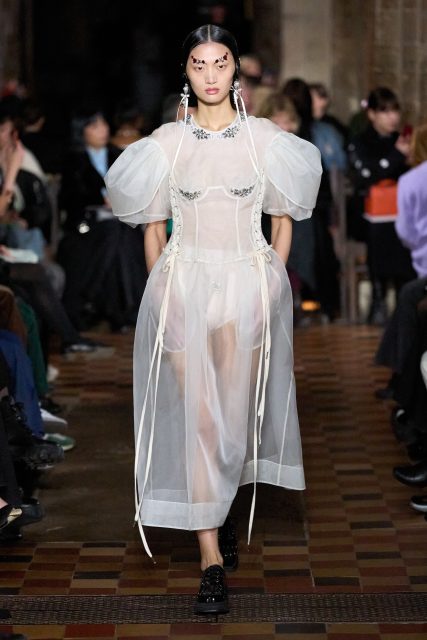Knitting and slippers. Old-style English underwear and slippers. Grandma hair, grandpa coats—and slippers.
Jonathan Anderson is the absolute fashion mastermind when it comes to planting bizarre, irrational ideas and making them desirable (think of last season’s plasticine shorts and hoodies). But he outdid even himself when cited Last of the Summer Wine as his fall inspiration. Save yourself from Googling: This was a long-running British TV comedy show about the exploits and rivalries of a bunch of old-age pensioners in a village in Yorkshire. Their clothes—worn-out English tweeds, wooly hats, slippers, and many layers of cozy unmentionables (as seen on washing-lines by neighbors)—satirized a slice of northern working-class culture. Anyone who was brought up in the UK, and who considered themselves to be young, cool and edgy at the time would never have been caught dead watching it. But now….
Nostalgia isn’t what it used to be, as Anderson has sharply noticed. We’re in an age when the uncoolest things can suddenly blow up from no-where to become the coolest. “We wanted to do something a bit psychological this time; this idea of the grotesque and the pragmatic,” he said afterwards. “I was looking at a kind of colloquialism in terms of fashion, this idea of odd types of Britain—like the nosy next door neighbor in Last of the Summer Wine—which is a very strange thing, part of the furniture here.”
Of course Anderson has studied the phenomenon of unexpected swerves of taste which are coming from young people, “like Kate Bush at the top of the charts, or Tracy Chapman,” he said. “Things can pop up again from 50 years ago with the same energy. Age can be glorified and glamorized.” The designer discovered this for himself by accident when young people started picking up knitting needles during the pandemic and copying the JW Anderson patchworked hand-knit that Harry Styles had worn. Respect and affection for their grandparents, and everything their way of living represented was surging back in grandchildren (especially as old people were separated from the young, and dying, cut off from their families. Grandkids were even cheated out of their funerals.)
But back to the colorful, possibly mindful, youth-knitting: Soon Anderson was getting behind it by issuing the cardigan knitting pattern, open source. So it was clearly a cozy brand identity-confirming move to send out a mini dress entirely made of skeins of yellow knitting wool, worn with brown sheepskin slippers as his first look. To be precise, they weren’t literal granddad slippers, but suede and shearling ankle boots. Sometimes brown, sometimes black, they had been squared off (literally) in the design phase, and made so recognizable by repetition (everyone in the show wore a pair) that by the end, what started as grandad coziness had become ultra-desirable coolness. Anderson’s unique talent—which extends across his namesake label and Loewe—is the ability to transform a concept into a product like nobody else. Even grandma’s gray hairdo became an avant-nostalgia accessory. “They’re hats!” he revealed.
The reduced, almost blunt clarity of his this-plus-that presentation left no message unseen. Yet it was affectionate, too. Anderson garlanded some looks with ribbon-streamer hip-belts, “like horse-riding rosettes,” he said. Given the embedded vegetation, maybe they were also a coded, affectionate-hilarious tribute to the fiercely-fought parish competitions for best-in-show flowers and outsize garden produce that were the subject of many an absurd plotline in Last of the Summer Wine.
Editor
Sarah MowerCredit
Lead image: Filippo Fior / Gorunway.com

